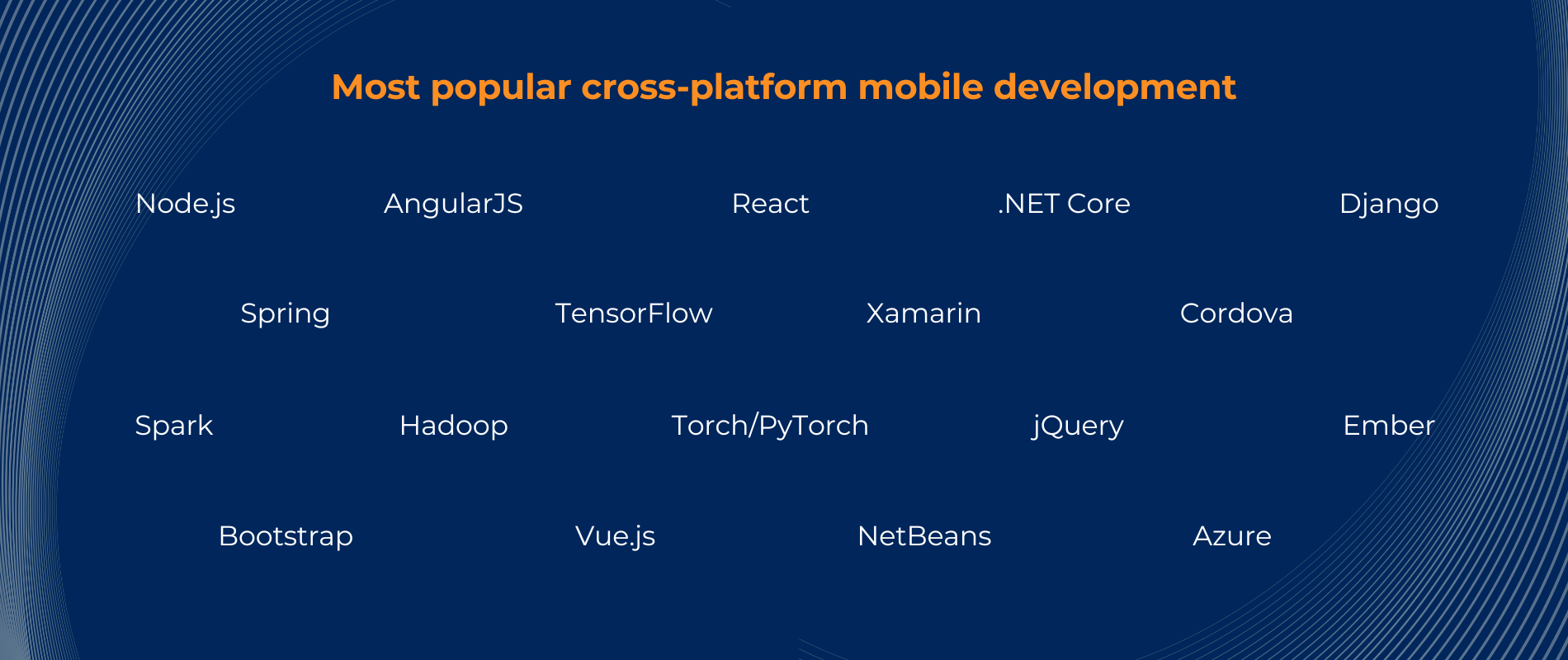Unlocking the Potential of Cross-Platform Development: Tools and Libraries You Need to Know


In the rapidly changing world of software development, cross-platform application development platforms have become a real breakthrough. These platforms provide developers with the opportunity to write code once and deploy it on multiple platforms, whether it’s iOS, or Android, or the Web. However, meeting the needs of multiple platforms such as iOS, Android, and the web can be a daunting task for developers. This is where cross-platform app development frameworks come on the scene, offering a simplified solution for building applications that can run seamlessly. In this article, we will delve into the field of cross-platform development, consider what this entails, why it is gaining popularity, its advantages and the best tools, frameworks, and libraries that expand the capabilities of developers in this area.
The cross-platform Application Development platform is a set of tools, libraries, and manuals that allow developers to create applications that can run on multiple platforms using a single code base. These frameworks eliminate the complexities associated with a particular platform, allowing developers to focus on writing code that runs on various devices and operating systems. As a rule, they use a single code base to create multiplatform mobile app development that run natively on different operating systems.
Cross-platform application development frameworks are gaining popularity for a number of good reasons. Exactly:
Implementing separate applications for each of the platforms can be expensive and take quite a lot of time. Cross-platform development reduces development costs, and allows developers to write code once and deploy it on multiple platforms, thereby speeding up the development process.
With cross-platform development, professionals can reach a wider audience faster by deploying their applications simultaneously on multiple platforms.
Creating software products that run on multiple platforms provides an opportunity for developers to reach a wider audience, maximizing the potential user base.
Reliable support of a single code base for multiple platforms greatly simplifies the development process, reduces the likelihood of errors and simplifies updates and maintenance.
Maintaining a single code base is much easier and more efficient than managing separate code bases for each platform.
Cross-platform app development frameworks can typically have community support, extensive documentation, and a wide range of third-party plugins and libraries. This process simplifies and increases the efficiency of development.
A unique opportunity to reuse the code. IT professionals can use a significant part of their code base, which they have written, on different platforms more than once. This helps to reduce redundancy and save time.
Now let’s have a look at some of the best frameworks for mobile apps, tools, and libraries that empower developers in the field of cross-platform application development:

The popular Node.js is a JavaScript runtime environment that allows developers to create scalable, high-performance, and flexible server applications. Its event-driven, non-blocking I/O model makes it ideal for building real-time web applications.
AngularJS is a JavaScript framework supported by Google for implementing dynamic and modern web applications. It provides a comprehensive solution for front-end development. It also offers features such as data binding, dependency injection, and modularity.
It’s one of the best cross-platform development frameworks. React is a JavaScript library for creating user interfaces developed by Facebook. As a rule, its component architecture and virtual DOM make it highly efficient and suitable for creating large-scale web applications in any field.
.NET Core is an open-source cross-platform platform for building modern cloud applications. It provides a unified development model for creating web, mobile, and desktop applications on Windows, macOS, and Linux.
It is a high-level web framework in the Python programming language. It promotes fast development and clean, pragmatic design. In addition, Django is based on the philosophy of “batteries on”, providing developers with everything they need to create web applications out of the box.
It is an easy-to-use open-source framework for creating enterprise-grade Java applications. Spring provides comprehensive infrastructure support for Java application development. It covers aspects such as dependency injection, aspect-oriented programming, and transaction management.
It is an open-source machine-learning platform specifically developed by Google to create and train machine-learning models. TensorFlow provides a flexible architecture for deploying machine learning algorithms on various platforms, including mobile devices and the Internet.
The Xamarin cross-platform is designed for application development, which allows developers to create their own mobile applications using C# and .NET. It provides reliable tools and libraries for creating applications for iOS, Android and Windows with a common code base.
Cordova’s open-source platform enables the creation of mobile applications using web technologies. Such as HTML, CSS, and JavaScript. It allows developers to create hybrid applications that run on multiple platforms using a single code base with cross-platform tools.
Spark is a fast general-purpose cluster computing system for processing large amounts of data. Spark also provides APIs in Java, Scala, and Python for creating parallel applications. They can scale from one machine to thousands of nodes.
Hadoop is an open-source platform for distributed storage and processing of large datasets. Hadoop can provide a scalable, fault-tolerant platform for storing and analysing big data using the MapReduce programming model.
Torch is a scientific computing platform with extensive support for machine learning algorithms. PyTorch is an open-source deep learning platform built on top of Torch and provides a flexible and intuitive interface for creating and training neural networks.
A fast, small and feature-rich JavaScript jQuery library for simplifying HTML document viewing, event handling, animation, and Ajax interaction. jQuery is in demand in creating dynamic and interactive web applications.
Ember.js is a JavaScript framework for creating ambitious web applications. It ensures strict compliance with the configuration philosophy. This allows developers to easily create complex web applications with a minimum amount of boilerplate code.
Bootstrap is a popular framework based on HTML, CSS, and JavaScript for the development of responsive web projects and web applications aimed at mobile devices. It provides a set of ready-made templates and components that simplify the development process. They also ensure consistency across devices.
It is a progressive JavaScript framework for creating user interfaces. It is designed from scratch so that it can be gradually implemented, which allows developers to easily integrate it into existing projects.
It is an open-source integrated Development Environment (IDE) for creating desktop, mobile, and web applications using Java, JavaScript, PHP, and other programming languages. It provides advanced code editing, debugging, and profiling tools to optimize the development process.
Azure is a cloud computing platform and services provided by Microsoft. It offers a wide range of cloud services, including computing, storage, network services, databases, analytics and machine learning, which allows developers to easily create, deploy and manage applications.
Choosing the best language for cross-platform apps is crucial for ensuring seamless functionality across multiple operating systems and maximizing development efficiency
In conclusion, cross-platform application development platforms provide developers with a powerful arsenal of tools, libraries, and resources to create applications that can run on multiple platforms without problems. “How to make a cross-platform app” is not only a question, but also the key to developing an application capable of running on various operating systems, without unnecessary costs and efforts. Due to the growing demand for multi-platform applications, the development of these platforms is becoming increasingly important for developers seeking to unlock the full potential of their projects. Whether it’s web development, mobile application development, or processing large amounts of data, the tools, and libraries mentioned above provide developers with the means to solve any task and provide innovative solutions to users around the world. With the right tools and libraries, developers can unleash the full power of cross-platform development and create innovative applications that will be relevant to users on different platforms.